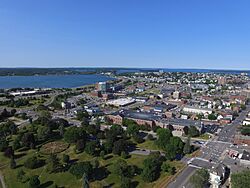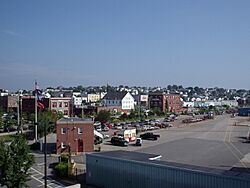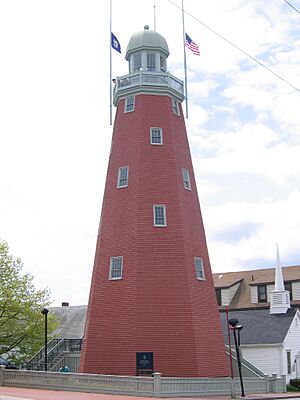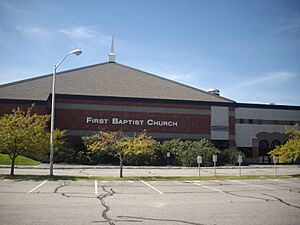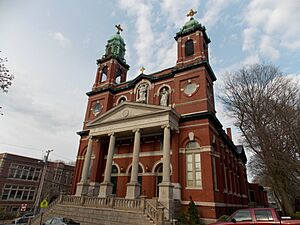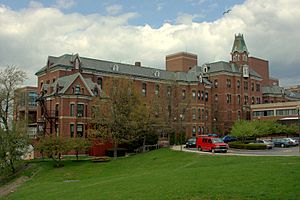Neighborhoods in Portland, Maine facts for kids
Portland, Maine, is home to many interesting neighborhoods, each with its own unique feel and history. Let's explore some of them!
Contents
Arts District
Portland's Arts District is a lively area in downtown Portland, mainly found along Congress Street. This district is a hub for creativity and learning. Here, you'll find places like the Portland Museum of Art, where you can see amazing artworks, and the Children's Museum of Maine, which is full of fun, hands-on exhibits. The Maine College of Art (MECA) is also here, where students learn to be artists and designers. You can also catch shows at the historic State Theatre. This neighborhood is a mix of homes and businesses, making it a busy and exciting place to live and visit.
Back Cove
Back Cove is a neighborhood located just outside Portland's main peninsula. It's mostly a quiet place to live, with some shops and businesses around Woodford's Corner and Ocean Avenue. From Back Cove, you can see great views of the Portland skyline across the water. This neighborhood is next to Deering Center, North Deering, East Deering, Rosemont, and Oakdale.
Inside Back Cove, you'll find Cheverus High School, a private school, and Ocean Avenue School, an elementary school. Many old and beautiful homes are in this area. The John B. Russwurm House and the Sparrow House are two of these historic buildings.
The Back Cove Trail is one of Portland's oldest and most popular trails. It's about 3.6 miles (5.8 km) long and goes all the way around Back Cove. It connects to Payson Park, the Bayside Trail, and the East End Trail. Payson Park is a huge 48-acre (19-hectare) park in the neighborhood. It has fields for baseball and softball, basketball courts, tennis courts, a playground, and even an ice skating rink and sledding hill in winter! There's also a community garden and the Longfellow Arboretum.
Bayside
Bayside is a downtown neighborhood located between Portland's Old Port and Back Cove. It has a mix of homes and businesses, with both old and new buildings. The neighborhood is bordered by Forest Avenue, Interstate 295 (I-295), Congress Street, and Franklin Street. It's next to the Parkside, Old Port, and East Bayside neighborhoods.
Portland High School, which has a building from 1863, and Baxter Academy, a high school focused on science, technology, engineering, and math (STEM), are both in Bayside. You can also find Merrill Auditorium here, a big theater where many shows and concerts happen. The only Whole Foods and Trader Joe's supermarkets in Maine are located in Bayside.
Some interesting buildings in Bayside include the Schlotterbeck and Foss Building, an old factory from 1927 that is now apartments, and Franklin Towers, a tall apartment building built in 1969. Many of Bayside's homes, including some very old ones, were saved from the Great Fire of 1866. An old city work center in Bayside has been turned into a fun area with restaurants, breweries, and a bowling alley.
The Bayside Bowl bowling alley is famous for hosting the PBA League Elias Cup team competition since 2014. The PBA League says Bayside Bowl has made their event much more exciting!
The Bayside Trail starts on Elm Street in this neighborhood. It crosses Franklin Street and goes through East Bayside, connecting to the East End Trail and the Back Cove Trail. The Stone Street Playground is also in Bayside, and it's very popular in summer because of its splash pad fountain.
Deering Center
Deering Center is a neighborhood that stretches from Brighton Avenue to Forest Avenue and Walton Street, past Evergreen Cemetery. This area was once its own town called Deering, named after Captain James Deering. It became part of Portland on March 9, 1899.
Deering Highlands
Deering Highlands is a neighborhood mostly made up of homes, located on a hill. It's generally bordered by Woodford Street to the north, Stevens Avenue to the west, and Deering Street to the east. This neighborhood was developed in the late 1800s and still has much of its original look, with many beautiful old houses.
While it's mostly homes, the biggest building here is Maine Medical Center's Brighton Avenue Campus. This complex now includes the New England Rehabilitation Hospital of Portland and has training facilities and an urgent care center.
East Deering
East Deering is the easternmost neighborhood in Portland. It has homes along the waterfront, other residential areas, Payson Park, and will be the future home of the Roux Institute. This area became part of Portland along with other Deering neighborhoods. The first Europeans who settled here were farmers. Today, it's a suburban neighborhood located between Munjoy Hill and North Deering, and the town of Falmouth. East Deering has a mix of different types of homes, from smaller houses to larger, more expensive ones.
You can find businesses like restaurants, an ice cream shop, and a juice bar on Washington Avenue and Veranda Street. Many parts of the neighborhood have amazing views of Casco Bay and nearby Mackworth Island. Important landmarks here include Tukey's Bridge, the old B&M Baked Beans factory, Martin's Point, Presumpscot School, and Payson Park. In 2021, the Roux Institute bought the B&M factory to turn it into a campus with school buildings, student housing, a hotel, and public access to the waterfront.
Martin's Point Bridge connects East Deering to Falmouth.
East Bayside
East Bayside is bordered by Franklin Street to the west, Washington Avenue to the east, Marginal Way to the north, and Congress Street to the south. It's next to the Bayside, Old Port, and Munjoy Hill neighborhoods. This area started to develop its streets in the early 1800s. By the 1820s, it became Portland's second seaport. After the Great Fire of 1866, a lot of the fire's debris was put into Back Cove, which made East Bayside much larger. Maps from around 1900 show the shoreline extending out to Marginal Way. East Bayside is sometimes confused with Bayside, which is on the other side of Franklin Street.
East End
The East End is a neighborhood at the very eastern tip of Portland's peninsula. It's closely connected with Munjoy Hill and the Eastern Promenade. The East End Community School, on North Street, serves the children in this area. The East End Beach is also located here, a great spot for swimming and relaxing. A notable building is the Portland Observatory, built in 1807, which sits high up on Munjoy Hill and offers amazing views.
Libbytown
Libbytown is a neighborhood in southern and western Portland. It's located between the Stroudwater, Rosemont, Oakdale, and Parkside neighborhoods. The Fore River separates it from the city of South Portland. Maine's busiest public transportation hub, the Portland Transportation Center, is found in Libbytown.
Nasons Corner
Nasons Corner is the area around outer Brighton Avenue. In the 1890s, when it was part of the independent town of Deering, this area was mostly farmland with strawberries and hay fields. Capisic Brook runs through the neighborhood. In 1898, Nasons Corner became part of the City of Portland. The first homes were built around that time. The Glenwood project, started around 1900, included affordable bungalow-style homes named after English counties.
Sagamore Village
During World War II, many people from rural Maine moved to Portland because there were lots of jobs in the defense industry around Portland harbor. To help with the housing shortage, Sagamore Village was built in 1943. It was a unique community because it was home to people of many different races and backgrounds. After the war, the government wanted to sell housing developments like Sagamore. The city of Portland eventually bought the complex in 1950, and it became available for people with lower incomes.
North Deering
North Deering is the northernmost neighborhood in Portland. It's next to the Riverton and East Deering neighborhoods, and the town of Falmouth. This area is home to some of the oldest houses in the city because it was saved from the four big fires that damaged much of Portland in the past. Long ago, North Deering's economy was based on farming and lumber. Today, it's a suburban neighborhood with some shops. It's home to WGME, Portland's local CBS TV station. The Presumpscot River Preserve, a 48-acre (19-hectare) nature area, is also located in North Deering.
Children in North Deering attend Harrison Lyseth Elementary School and Lyman Moore Middle School. For high school, students can choose between Portland High School, Deering High School, or Casco Bay High School.
Oakdale
Oakdale is mainly a neighborhood for homes, and it's very close to the university. Most homes are owned by the people who live in them. The Portland campus of the University of Southern Maine is located here, and everything in the neighborhood is within walking distance of the university.
The neighborhood includes the Southworth Planetarium, where you can learn about space, and the Glickman Library. Parks in Oakdale include Baxter Boulevard, Longfellow Park, Noyes Park, and Fessenden Park. The Deering Avenue bridge connects Oakdale to Deering Oaks and the city's sports complex, which has Fitzpatrick Stadium, Hadlock Field, and the Portland Expo. Shops and businesses are mostly found along Forest Avenue.
The historic Nathan Clifford School, built in 1907, was the neighborhood school until it closed in 2011. It was later remodeled into apartments.
Old Port
The Old Port, sometimes called the Old Port Exchange, is a famous neighborhood known for its cobblestone streets, old brick buildings from the 1800s, and fishing piers. This area is full of unique shops, restaurants, and cafes. Because it's known for its lively nightlife, the Old Port is a very popular place for both tourists and local people to visit. It's bordered by the Bayside, East Bayside, Munjoy Hill, and West End neighborhoods.
Parkside
The Parkside neighborhood is located at the base of the Portland peninsula. It's bordered by I-295, Forest Avenue, Congress Street, and Weymouth Street. Parkside is next to the West End, Bayside, and Libbytown neighborhoods. This neighborhood began after the 1866 fire, which burned much of Portland's waterfront. Many residents moved to this area, and streets were named after Civil War generals. The homes here are mostly triple-decker buildings, and the neighborhood soon became home to many Italian and Irish immigrant families.
Peaks Island
Peaks Island is the island with the most people living on it in Casco Bay, and it's part of the city of Portland. It's about 3 miles (4.8 km) from downtown Portland. You can get to the island by Casco Bay Lines ferry. Peaks Island has its own elementary school, library, and police station. It's the only island in Casco Bay where cars are allowed, because of its size.
Riverton
The Riverton neighborhood is in northwestern Portland. The Riverton Trolley Park, a popular leisure spot, was located here from 1896 to 1929. A trolley used to bring people from Monument Square to the park. A branch of the Portland Public Library is also in Riverton. Riverton Elementary School serves as the neighborhood school. The University of New England (UNE) has a campus here, which used to be Westbrook College.
Rosemont
Rosemont is a neighborhood close to Deering Center and other areas outside the peninsula. Longfellow Elementary School, Lincoln Middle School, and Deering High School are all located here. The local branch library, Burbank Library, is one of the busiest libraries in Maine. Capisic Pond, a great place for outdoor activities, is also found in Rosemont.
Saint John Valley
The Saint John Valley Neighborhood is located between the West End and Libbytown neighborhoods, bordered by the Parkside Neighborhood and the Fore River.
The Saint John Valley Neighborhood Association was created in 2008 to help bring more attention and funding to this part of the city. Since then, many improvements have been made, and more are planned, such as making the streets safer and more beautiful for people walking.
Stroudwater
Stroudwater is in the southwest corner of Portland. It's bordered by Nasons Corner and Libbytown to the north and east, and the cities of Westbrook and South Portland. Maine's busiest airport, the Portland International Jetport, was originally known as Stroudwater Field and is located here. Stroudwater has several historic buildings, including the Tate House and Museum, built in 1755, which is the oldest publicly accessible building in Portland. The James Forder house, built in 1730, is recognized as the oldest house in Portland. The Stroudwater Historic District is also here, and it's where the Stroudwater River meets the larger Fore River.
Stroudwater started as a small village that was important for making masts for the Royal Navy, using power from the Stroudwater and Fore Rivers. Today, Stroudwater is considered a quiet suburban area, even though it's still officially part of Portland.
West End
The West End neighborhood is on the western side of Portland's peninsula. It's famous for its many historical and well-preserved buildings.
Known for its beautiful architecture, the West End has many historic homes and the Western Promenade Historic District. In 2010, it was even called "one of the best preserved Victorian neighborhoods in the country." The Western Promenade is a major feature of the neighborhood, offering great views. Other historical buildings include The Gothic House and the Morrill Mansion. The Western Cemetery, Portland's main cemetery from 1829 to 1852, is also in the West End. Maine Medical Center, Maine's largest hospital and Portland's biggest employer, is located here. Mercy Hospital, which started as Queen Anne's Hospital in 1918, is now the fourth-largest hospital in Maine and is also in the West End.



